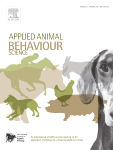Document type : online pre-publication of scientific article in Applied Animal Behaviour Science
Authors: E Kieson, C Felix, S Webb, CI Abramson
Résumé en français (traduction) : Les humains utilisent les récompenses alimentaires comme un renforcement positif pour l’entraînement des chevaux, mais il n’y a guère de preuves que l’interaction humaine (grattage ou caresses) ait une valeur de récompense ou si les chevaux domestiques perçoivent le contact humain comme un lien social. La plupart des entraînements équins sont basés sur le renforcement négatif, mais la nourriture est une récompense connue pour l’entraînement par le renforcement positif. Cette étude a examiné comment les chevaux perçoivent l’interaction humaine comme une forme de récompense positive en examinant si le grattage et les caresses peuvent servir de récompense pour un comportement et comment cela se compare aux récompenses connues (friandises) basées sur la capacité des chevaux à utiliser des symboles pour montrer leurs préférences. Un objectif secondaire de cette étude était d’explorer les comportements avant, pendant et après le test de choix et les changements de code basés sur l’éthologie équine connue et de déterminer toute corrélation entre les antécédents individuels connus des chevaux, leur comportement, et toute différence de préférences pour les interactions humaines selon que l’humain est familier ou non. Pour le volet quantitatif, l’étude a compté le nombre de fois que chaque cheval a touché chaque cible (comptage des touches) et les comportements ont été enregistrés à l’aide d’une caméra GoPro Hero. Le nombre de touchers pour chaque symbole du dernier essai a été comparé à l’aide de la modélisation orientée vers l’observation (OOM), une approche non-paramétrique pour identifier des modèles dans les données, et les comportements ont été codés et comparés aux comportements connus dans l’éthologie équine. L’analyse rétrospective du nombre de touches finales a permis d’obtenir un schéma de moins de deux touches pour les grattages et les caresses pour la plupart des chevaux et de dix touches (le maximum) pour les friandises pour tous les chevaux. L’analyse rétrospective du schéma a donné un indice de classification correcte en pourcentage (PCC) de 93,94 (valeur c < 0,001) pour l’humain familier et de 87,88 (valeur c < 0,001) pour le chercheur non familier, ce qui suggère que, compte tenu des conditions de l’étude, tous les chevaux de cette étude ont montré une préférence pour les friandises par rapport au contact humain, indépendamment des antécédents de manipulation ou d’entraînement. Tous les chevaux ont également montré des comportements d’excitation pendant l’étude, ce qui suggère que l’étude, et potentiellement le composant de nouvel aliment, a induit une réponse d’excitation.
Résumé en anglais (original) : Humans use food rewards as positive reinforcement for training horses, but there is little evidence to show that human interaction (scratching or patting) has reward value or if domestic horses perceive human touch as social bonding. Most equine training is based on negative reinforcement, but food is a known reward for training through positive reinforcement. This study looked at how horses perceive human interaction as a form of positive reward by examining whether scratching and patting can serve as a reward for a behavior and how this compares to known rewards (treats) based on horses’ ability to use symbols to show preferences. A secondary purpose of this study was to explore behaviors before, during, and after the choice test and code changes based on known equine ethology and determine any correlations between known individual histories of horses, their behavior, and any differences in preferences for human interactions based on whether the human was familiar versus unfamiliar. For the quantitative component, the study counted the number of times each horse touched each target (touch counts) and behaviors were recorded with use of a GoPro Hero camera. The touch counts for each symbol for the last trial were compared using Observation Oriented Modelling (OOM), a non-parametric approach to analyze patterns in data, and the behaviors were coded and compared to known behaviors in equine ethology. Post-hoc analysis of final touch counts resulted in a pattern of fewer than 2 touches for both scratches and pats for most horses and consistently ten touches (the maximum) for treats for all horses. Post-hoc pattern analysis resulted in a Percent Correct Classification (PCC) index of 93.94 (c-value <.001) for the familiar human and 87.88 (c-value <.001) for the unfamiliar researcher suggesting that, given the study conditions, all horses in this study showed preference for treats over human contact, regardless of handling or training histories. All horses also displayed arousal behaviors during the study suggesting the study, and potentially the novel food component, induced an arousal response.






